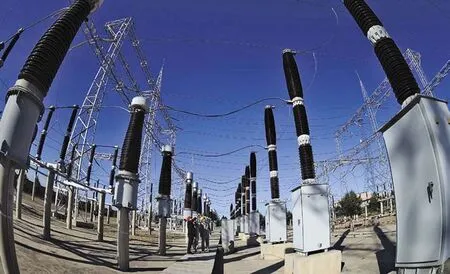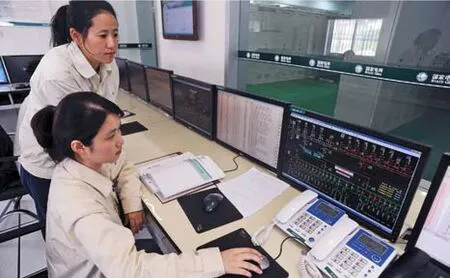Why the Tiers?
2010-10-16ByLANXINZHEN
By LAN XINZHEN
Why the Tiers?
By LAN XINZHEN
China mulls a tiered pricing system to curb household electricity use

EXPENSIVE POWER: Technic ians check a 220-kv transfo rm er station in Jilin Province. Prices o f e lec tric ity cou ld rise ac ross China if a tiered system is adop ted
A s part of ongoing green efforts,China w ill soon adopt a tiered electricity pricing system to encourage residents to cut back on energy use. The government w ill first determine a basic electricity quota, and any consumption above that level w ill be charged at higher prices.
The National Development and Reform Comm ission (NDRC) announced the possible tiered pricing system on October 9 and requested public feedback from October 9-21.
NDRC statistics showed 70 percent of Chinese households consume less than 110 kwh per month; 80 percent consume less than 140 kwh; 90 percent less than 210 kwh; and 95 percent consume less than 270 kwh per month. In line w ith the statistics, the NDRC divided consumption into three tiers w ith prices increasing progressively and offered two sets of schemes for public opinion.
The first scheme is as follows: If the monthly electricity consumption is below 110 kwh, users w ill fall into the fi rst tier where the price will be maintained at the current level; if the consumption is between 110 kwh and 210 kwh, it will fall into the second tier and the resident will have to pay an extra 0.05 yuan($0.0075) per kwh; and if the consumption exceeds 210 kwh, the resident falls into the third tier and an extra 0.2 yuan ($0.03) w ill be charged in addition to the second-tier price.
The second scheme is more or less the same as the fi rst one, except the threshold for the first tier falls at 140 kwh w ith a charge of 0.01 yuan ($0.0015) more than the current level for consumption below 140 kwh. For the second and third tier, the threshold would be 270 kwh—electricity consumption between 140 kwh and 270 kwh w ill be charged an extra 0.05 yuan ($0.0075) per kwh, while the consumption above 270 kwh a month w ill be charged 0.2 yuan ($0.03) more.
The two schemes are subject to change.So far the online survey shows that netizens are in favor of the second proposal.
Necessary tiers?
Electricity prices of the power sector are determined by the NDRC. Residents in each province are subject to a unified and relatively low price. At present, the electricity price in Beijing is 0.48 yuan ($0.07) per kwh; the price in Guangdong Province is the highest of up to 0.61 yuan ($0.09) per kwh; and the price in Qinghai Province is the lowest at 0.42 yuan($0.06) per kwh.
In China’s power structure, thermal power accounts for 75.6 percent and hydropower 22.6 percent. Nuclear power accounts for only 1.3 percent. The proportion of new energy power,such as w ind power, is even smaller. As a result of its dependence on fossil fuels, coal in particular, the power industry in China has become a high polluting one.
Cao Changqing, head of the pricing department of the NDRC, said the ultimate purpose of adopting tiered electricity prices is to save energy and reduce carbon em issions.
In recent years, the Chinese Government had enacted a series of pricing policies to save energy and reduce emissions. For instance,companies with high energy consumption are subject to a differentiated electricity pricing system and companies w ith extraordinary power consumption have to pay punitive electricity prices. Those prices are higher than the current electricity price, some tw ice as high as current prices. Raising the price of power can enhance a company’s sense of energy conservation and environmental protection, said Cao.
However, in today’s world where energy is in short supply and the environment is degrading, it is not just companies’ responsibility to save energy—ordinary citizens are also obliged to cut emissions and save energy.The tiered electricity policy w ill in effect extend the industrial practice to households and urge them to use less power.
“A fter the tiered pricing system is adopted, households whose power consumption falls below the fi rst level w ill not feel much difference in terms of electricity expenses.But those who use more power will have to pay more and they might be motivated to use less electricity,” Cao said.
The ultimate goal for energy conservation and em ission reduction is to secure a sustainable grow th of economy and society.Therefore, “each one of us w ill be the beneficiary of the tiered pricing system,” he said.
M o re pow er, m o re p ro fit?
There are m ore than 2,000 pow er companies in China, 55 of which are listed companies. However, an overwhelming 90 percent of electricity is supplied by the big five state-owned power companies, including China Huaneng Group, China Guodian Corp., China Power Investment Corp., China Huadian Corp. and China Datang Corp. In addition, electricity sales are controlled by the big six power grids, including East China Grid Co.Ltd., China Southern Power Grid Corp. Ltd.,North China Grid Co. Ltd., Central China Grid Co. Ltd., Northeast China Grid Co. Ltd. and Northwest China Grid Co. Ltd.
Figures from the National Energy Adm inistration showed household power consumption in 2009 stood at 457.1 billion kwh, accounting for 12.55 percent of all social power consumption. If the tiered pricing system is adopted, an increment of tens of billions of yuan w ill be generated whether scheme No. 1 or scheme No. 2 is adopted.
Cao said part of the increment resulting from the price hike will be used for the follow ing three aspects.
First, it w ill be used to offset rising environmental protection cost of the power and grid companies. Currently, thermal power plants generate half of all sulfur dioxide emissions and are the major source of air pollution in China. To reduce emissions of sulfur dioxide, the power companies have installed desulfuration facilities which help reduce sulfur dioxide em ission. They need to be reimbursed, Cao said. And the rising power prices will urge them to take more effective measures to contain carbon emission.
Second, the money w ill be used to rep lace household electricity meters. A t present, households should pay for electricity meter replacements. But after the tiered pricing system is adopted, grid companies w ill no longer be allowed to charge households for the replacement.
Third, the recent price surge of electricity coal endangers thermal power plants whose costs are on the rise. The rise in electricity cost can help save the power companies and secure normal power supply.
China’s Elec tric ity Produc tion and Sales
From January-August 2010, total social power consum p tion in China stood at 2.794 trillion kw h, up 19.34 percent year on year. Am ong that, industrial electricity consum p tion was 2.095 trillion kwh, grow ing 21.47 percent from the sam e period last year; urban and rural household electricity consum p tion stood at 335.5 billion kw h, rising 12.97 percent year on year.
Du ring this period, a total o f 196.6 billion yuan ($29.6 billion) was invested in pow er p lants: 40.2 billion yuan ($6.1 billion) in hyd ropow er p lants; 73.6 billion yuan ($11.1 billion) in thermal power p lants; 35.9 billion yuan ($5.4 billion) in nuc lear power p lants; and 46 billion yuan ($6.9 billion) in w ind power p lants.New ly increased power p roduction stood at 471.3 mw; hyd ropower p roduction at 950 mw, down 7.3 percent year on year; thermal power p roduction at 329.1 mw, up 21.8 percent year on year; and w ind power at 454 mw, up 27.6 percent year on year.
(Source:National Energy Adm inistration)

DOUBLE CHECKING: Technic ians at a pow er g rid com pany use hi-tech fac ilities to supervise operations on Sep tem ber 30 in Feidong County, He fei in Anhui Province
Residents’ response
Figures from the NDRC show considerable differentiation in the urban and rural household monthly electricity consumption.In 2009, average urban household electricity consumption was about 140 kwh a month,while that of the rural areas was just 60 kwh.It’s no surprise then that the NDRC’s request for comments has mostly caught the attention of urban residents.
“I support this motion. People who use more should pay more. And this w ill urge people to save energy and live a low energy consum ing life,” said Zhang Changquan, a Beijing resident.
Zhang said he had a habit of turning off the electricity when it was unnecessary, and family members who forgot to do so would get an “earful.”
But some people are against the proposal.“It’s just another price hike in the disguise of reform and energy conservation,” said Wang Weihan, an energy expert at the University of International Business and Econom ics.
Wang said the prerequisite for an electricity price hike is strict cost supervision and calculation. “As a monopolistic industry,power companies must be supervised, which is the basic requirement for maintaining their status as a monopoly. Otherw ise, no one can be sure about whether their costs have indeed increased or not,” said Wang.
Wang said from the perspective of policymakers, they are merely concerned about the energy conservation indexes. But as for ordinary citizens, their appeal to maintain their current livelihoods should always come the first. Water, gas and electricity are the daily necessities—and they are paying close attention to the price hikes of those public goods.
tens of thousands of comments via the Internet and is now using those comments to make appropriate changes to the proposed mechanism. The tiered pricing system is likely to be officially adopted at the beginning of next year.
